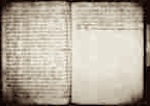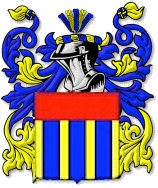
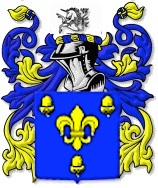 | | Moral |
|
The "Moral" surname was first found in Brittany, where the family has been seated since ancient times. The Family Coat of Arms features a blue shield with a silver fleur-de-lis between three gold acorns. The Family Crest is a unicorn issuant, and the Family Motto is "Nescit labi virtus."
QUENTIN MORAL was born sometime around 1620 in a village called St. Quentin in Lorraine, a region in northeastern France now bordering Belgium, Luxembourg and Germany. Always ambitious, Quentin sailed to "New France" (Canada) to make his fortune, but his exact arrival date is unknown (probably around 1645). Between the years 1648-51, he was among forty or so colonists who established homesteads at Trois-Rivières (Three Rivers), located on the north shore of the Saint Lawrence River at the confluence with the Saint-Maurice River. Trois-Rivières had been founded on July 4, 1634, the second permanent settlement in New France, after Québec City. They enclosed the town in a stone palisade as protection from local Algonquin and Abenaki tribes. Quentin was a soldier in the "mobile patrol" in 1651.
In approximately 1652, Quentin married MARIE MARGUERIE, the daughter of FRANÇOIS and MARTHE ROMAIN of St-Vincent, Rouen, France. At the time, Marie was the widow of Jacques Hertel dit Lafresniere, whom she had married on 23 Aug 1641 in Trois-Rivières. She was also the sister of the well-respected interpreter and fur trader, François Marguerie, and inherited land on an island called l'Île de la Trinité from François when he died in 1648. After her marriage to Quentin, the island was renamed l'Île Saint-Quentin. Marie also brought three young children to the marriage, aged 3 to 10, along with the land. She bore Quentin four daughters:
CHILDREN OF QUENTIN MORAL AND MARIE MARGUERIE |
| MARIE-JEANNE MORAL was born in 1653 in Trois-Rivières, Québec. She was the first of four daughters of Quentin Moral and Marie Marguerie. Quentin also saw that his daughters would marry well and that their husbands were provided with adequate dowries in terms of land and titles. In late 1667 Marie-Jeanne was married to Jacques Maugras (1639-1690) at the age of 15. Children: Marie-Jeanne (1668-1755), Marguerite (1674-1746), Madeliene (1685-1740), and Marie-François Maugras (1688-1688). Maugras and Marie's sisters' husbands would eventually move to Saint-François-du-Lac,³ the settlement founded by Marthe's step-brother-in-law, Jean Crevier. She died on 20 Jan 1714 in Saint-François-du-Lac, Yamaska, Québec. |
| MARIE-THERESE MORAL was born on 31 Oct 1655 in Trois-Rivières, Québec. At age 26, she was married to Etienne Grandmenil Degrammenil Veron, a fur trader of some means, at 30 May 1677 at Trois-Rivières, Québec. Veron had also been born in the raw frontier post of Trois-Rivières. At age three his father was killed by Iroquois. His mother remarried the noted explorer Medard Chouart. However his new stepfather applied severe corporal punishment to the headstrong Veron—and he was then entrusted to a guardian at a cost of 20 livres a year. When Veron was older, he was sent to the Jesuits for education and discipline. At the age of 18 he was back living with his mother—the stepfather evidently being away on the fur trade. He had prospered enough by age 28 to marry Marie-Therese, which truly put him in the upper ranks of the small society of Trois-Rivières. Veron was of high enough rank to be one of twenty at Trois Rivieres who met to fix the price of beaver furs that year. Children: Etienne (1679-1743), Marguerite (1678-1748), Veronique (1682-1711), Marie Madeleine (1684-1760), Marie Renee (1687-1704), Therese (1689-1710), Marie Jean (1695-1756), and Louise François Grandmenil Veron (b. 1697). Marie-Therese died on 7 Apr 1734 in Trois-Rivières, Mauricie Region, Québec. |
 |
MARIE-GERTRUDE MORAL was born on 22 Mar 1658 in Trois-Rivières, Québec. She was 18 when she married JACQUES LOUIS JOUIEL on 10 November 1676 at Trois-Rivières. It is speculated that Marie's mother, Marie Marguerie, had objected to the union, possibly believing her daughter was marrying beneath her station to a man who was interested in her potential wealth. In the marriage contract of 2 November it was recorded that the husband brought 1500 livres to the marriage, while the bride brought 600 livres (the dowry from her father), and the title of Lady, which she inherited from her mother. The contract was witnessed by several relatives and friends: Louis Godefroy, attorney of the King at Trois-Rivières, and one of the co-founders of the place together with Marie's first husband, Jacques Hertel; Etienne de Tonnancourt; Jacques de Labadie, Sergeant of the garrison of Trois-Rivières; Joseph Petit; and Jean Crevier, Jacques' future brother-in-law, and Seur of Saint-François-du-Lac, Québec. Jacques Jouiel was born around 1640 in Perigord, Dordogne, France (the place gave its name to a Paleolithic cultural phase - the Perigordian - which is a remote connection to the mtdna roots of his wife). His father was Etienne Joyel, master gunsmith, and his mother Suzanne Massau, from nearby Bergerac. Children: Gertrude (1681-1732), Jean (b. 1683), MARIE-JOSEPHE (b. 1690), François (1691-1761), Joseph (b. 1694), and Antoine Joyelle (b. 1696). By 1685, Jacques, Marie-Gertrude and family were settled in at Saint-François-du-Lac with her brother Jean Crevier. In 1690, daughter Josephette was baptized there. The baptisms of his children in 1694 and 1696 had to be conducted in Sorel since the church in Saint-François was destroyed in a raid by the Iroquois during which Jean Crevier was captured. (He was tortured, ransomed, but died of his wounds.) On the 4 July 1698, Jacques' sons Jacques and Jean were granted some land in Saint-François-du-Lac by their uncle's son. The Joyel family became well established there. Jacques died at the age of 76 on 26 March 1716. Marie Gertrude Moral du St. Quentin survived him by twenty years, dying at age 78 at Saint-François-du-Lac on 28 August 1736. Her burial record is at right (SOURCE: Gabriel Drouin, comp. Drouin Collection. Montréal, Québec, Canada: Institut Généalogique Drouin¹). |
| MARIE-MARTHE MORAL was born on 1 Jan 1661 in Trois-Rivières, Québec. Marie Marthe Moral was married on 23 Nov 1682, at the age of 21, to Antoine Dubois, who was in his thirties. Nothing appears to be known of his birthplace or profession. Children: Marguerite (1685-1737), Antoine (b. 1683), Marie-Louise (b. 1687), Anne (b. 1689), Marie Charlotte (b. 1691) and Marie Claude Dubois (b. 1693). Quentin Moral had already engineered a complex land swap whereby Marthe's brother-in-law, Joyelle, moved to Saint-François-du-Lac, whereby Dubois obtained a property there, despite his evident inability to pay. Marie Marthe's family would join those of her sisters in Saint-François-du-Lac, and spend the balance of their lives there. She died on 18 Jan 1712 in Saint-François-du-Lac, Yamaska, Québec. |
In 1666 the first census was made of New France at the end of July, and Trois-Rivières had a population of 602, Montréal 760 and Québec 2,857, for a total of 4,219 people in Canada. The average age of the habitants of the Trois-Rivières region was approximately 13 years old. (Source: La population du Canada en 1666 by Marcel Trudel and published by Les éditions du Septentrion, Sillery [Québec], PQ, Canada). The Moral household at that point in time consisted of: "Quentin Moral sieur de Saint-Quentin, 44, habitant ; Marie Marguerie, 40, sa femme; Jeanne, 13 ; Marie, 10 ; Gertrude, 8 ; Marthe, 5 ; Robert Henry, 20, et Nicolas Dupuis, 24, domestiques". Marie's daughters by Jacques Hertel had already married and left the house. Trois-Rivieres and adjacent districts had grown in 20 years from a handful of settlers to a village of 69 families and 455 souls. However the town itself still consisted of only about two dozen households and less than a hundred Europeans. (Source: website Alberta Family Histories Society)
Marie Marguerie saw to it that her children received good educations. Her daughters by Quentin were educated at the Ursuline convent established just across the street from the Hertel house. Meanwhile, Quentin adopted the style 'Sieur de St-Quentin' and kept the family income up by selling Marie's inheritance from her first husband to newcomers to the New World. He also served in the military Royal Lieutenant in Canada on 22 Dec 1650; the Lieutenant civil et criminel du Roi habitant in 1666; and juge prévôt et lieutenenant civil et criminel (provost judge). On 17 Nov 1663, he was appointed royal notary but does not seem to have taken up the office, which was entrusted a year later to Séverin Ameau. Then in 1669, Quentin Moral made a concession of 3 arpents of land to Antoine Desrosiers in Trois-Rivières. At the time, Quentin Moral was seigneur of the property, 'L'Arbre-à-la-Croix' in François. In his remarkable life, he had come from inauspicious beginnings in France to become a prosperous landowner, agent, and a judge.
| Church Registers |
File Image |
| Name: | | Quentin Moral |
| Spouse: | | Gertrude Moral |
| Regiment: | | Enterrement (Burial) |
| Date: | | 1686 |
| Location: | | Trois-Rivières |
| Institution: | | Immaculée-Conception, cathédrale l'Assomption |
|
|
| |
SOURCE INFORMATION: Gabriel Drouin, comp. Drouin Collection. Montreal, Québec, Canada: Institut Généalogique Drouin.¹ |
Quentin Moral died in Trois-Rivières in 1686, but Marie Marguerie outlived him by 14 years, and on the day of her funeral the Recollect priest of the parish of François, Luc Filastre, sang her praises: "Today, November 26, 1700, Marie Marguerie, widow of the late St Quentin was buried. She died fortified by the rites of the Church and with every sign of extraordinary devotion, having lived for more than fifty years in the service of all in this town, their constant helpmate in time of need, showing incomparable charity and zeal, she worked for the Church performing the duties of the sacristy, and caring for the Church appointments incomparably well. She was buried, according to her wish, next to the body of M. Hertel, her first husband."
They are all buried at the Immaculée-Conception-de-la-Sainte-Vierge Cemetery in Trois-Rivières, Mauricie Region, Québec.
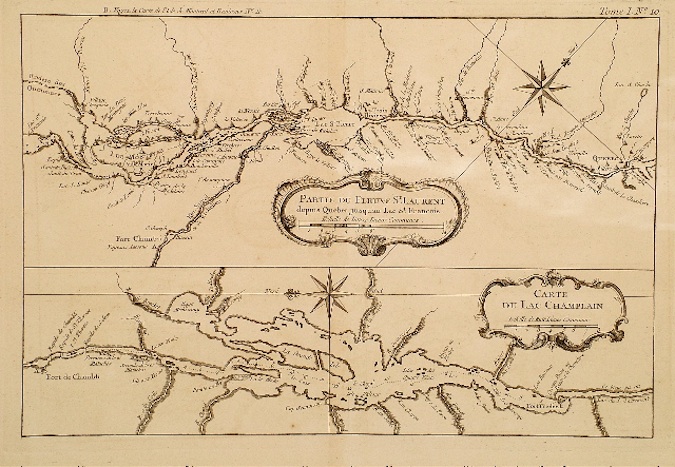
Partie du Fleuve St. Laurent depuis Québec jusqu'au Lac St. François / Carte du Lac Champlain. Map maker: Jacques Nicolas Bellin (1703-1772); Size : 8.3 x 12.4 inches. / 21.0 x 31.4 cm. (click to enlarge). From Bellin's Petit atlas maritime. Tome I N.10; Paris 1764. |
Their daughter MARIE GERTRUDE MORAL, who was born on 22 Mar 1658 in Trois-Rivières (Three Rivers), St Maurice, Québec, JACQUES LOUIS JOUIEL, who was born around 1640 in Périgueux, Dordogne, Aquitaine, France (the place gave its name to a Paleolithic cultural phase—the Perigordian—which is a remote connection to the mtdna roots of his wife). His father was ETIENNE JOYEL, master gunsmith, and his mother SUZANNE MASSAU, from nearby Bergerac.
Marie Gertrude Moral was 18 when she married Jacques Jouiel on 10 November 1676 at Trois-Rivières. It is speculated that Marie's mother, Marie Marguerie, had objected to the union, possibly believing her daughter was marrying beneath her station to a man who was interested in her potential wealth. In the marriage contract of 2 November it was recorded that the husband brought 1500 livres to the marriage, while the bride brought 600 livres (the dowry from her father), and the title of Lady, which she inherited from her mother. The contract was witnessed by several relatives and friends: Louis Godefroy, attorney of the King at Trois-Rivières, and one of the co-founders of the place together with Marie's first husband, Jacques Hertel; Etienne de Tonnancourt; Jacques de Labadie, Sergeant of the garrison of Trois-Rivières; Joseph Petit; and Jean Crevier, Jacques' future brother-in-law, and Seur of Saint-François-du-Lac. They had the following children:
CHILDREN OF MARIE-GERTRUDE MORAL AND JACQUES JOUIEL |
| GERTRUDE JOYELLE was born on 19 May 1681 in in Saint-François-du-Lac, Québec. She married Joseph Forcier (1677-1741) on 19 Feb 1703 in Saint-François-du-Lac. Children: Charlotte (b. 1704), Joseph (b. 1706), Marie-Jeanne-Joseph (b. 1708), Marie-Louise (b. 1710), Jean-Baptiste (1713-1714), Jean-Baptiste (b. 1715), Catherine-Agathe (b. 1716), Antoine-Augustin (b. 1717), Michel-Regis (b. 1720), and Ignace Forcier 1723). She died on 16 Apr 1732. |
| JEAN JOYELLE was born on 22 Sep 1683 in in Saint-François-du-Lac, Québec. |
| MARIE-JOSEPHE JOYELLE was baptized on 21 Sep 1690 in in Saint-François-du-Lac, Québec. She married PIERRE ABRAHAM DESMARAIS (b. 10 May 1691) on 28 Nov 1711 in Saint-François-du-Lac. Children: Ignace (b. 1714), Anonyme (1712-1712), Marie-Louise (b. 1716), Joseph (b. 1717), Marie-Agathe (b. 1719), Anne-Judith (b. 1721), Marguerite (1723-1768), Pierre (1726-1738), JEAN-BAPTISTE (b. 1728), Joseph (1730-1730), Jacques (b. 1731), François (b. 1732), and Antoine-Joseph Abraham Demarais (1735-1747). To see her baptism record, click on the image at right. (SOURCE: Gabriel Drouin, comp. Drouin Collection. Montréal, Québec, Canada: Institut Généalogique Drouin¹) |
| FRANÇOIS JOYELLE was born in 1691 in Trois-Rivières, Québec. He died on 19 Oct 1761 in Saint-François-du-Lac, Québec. |
| JOSEPH JOYELLE was born on 10 Jan 1694 in Sorel, Québec; He died on 12 Apr 1693 in Yamaska, Québec. |
| ANTOINE JOYELLE was born on 4 Apr 1696 in Sorel, Québec. He died in 1773 in Yamaska, Québec. |
For whatever reasons, within a few years, Jacques wished to move away from his father-in-law Moral in Trois-Rivières and settled in Saint-François-du-Lac³ with his brother-in-law Jean Crevier. The baptisms of his children in 1694 and 1696 had to be conducted in Sorel since the church in St-François was destroyed in a raid by the Iroquois during which Jean Crevier was captured. He was tortured, ransomed, but died of his wounds. On the 4 July 1698, Jacques' sons Jacques and Jean were granted some land in Saint-François-du-Lac by their uncle's son. The Joyel family became well established there. Jacques died at the age of 76 on 26 March 1716. Marie Gertrude Moral du St. Quentin survived him by twenty years, dying at age 78 at Saint-François-du-Lac on 28 August 1736.
GENEALOGY
QUENTIN MORAL (b. 1620) married MARIE MARGUERIE and begat...
MARIE-GERTRUDE MORAL (b. 22 Mar 1658), who married JACQUES JOUIEL (JOYAL) and begat...
MARIE JOSEPHE JOUIEL (JOYAL), who married PIERRE ABRAHAM DESMARAIS (b. 1691) and begat...
JEAN-BAPTISTE DESMARAIS (15 Nov 1728 - 12 Oct 1807) married MARIE ANGELIQUE ROY (b. 16 Mar 1734) and begat...
MARIE JOSEPHE DEMARAIS (b. 1762), who married ROBERT STOTT (20 Feb 1761 - 2 Apr 1836) and begat...
MARY STOTT (b. 1783), who married JOSHUA S. MANNING (8 Dec 1782 - 26 Aug 1848) and begat...
SARAH AGATHE MANNING (05 Aug 1810 - 19 Jul 1855), who married JULIUS ALBERT RAYMOND (24 Jun 1818 - 21 Feb 1879) and begat...
ALBERT JULIUS RAYMOND (1848 - 1924), who married LOIS MATILDA KILBOURNE (1851 - 1937) and begat... FLADELLA RAYMOND (1869 - 1961) who married FRANK HAUSE (1867 - 1951) and begat...
CARLISLE HAUSE (1891 - 1972) who married MARJORIE MARCHANT (1892 - 1939) who begat...
CARLETON MARCHANT HAUSE, SR. (1917 - 1983) who married JEANNE BRUNNER (1918 - 2000) and begat...
CARLETON MARCHANT HAUSE, JR. (b. 1939) who married MARTHA WENK (b. 1940) and begat...
JEFF (who married LORI ANN DOTSON), KATHY (who married HAL LARSEN), ERIC (who married MARY MOONSAMMY), and MICHELE HAUSE (who married JOHN SCOTT HOUSTON). |
NOTES
¹—Until the late 1900s, church registers in Quebec served as civil and vital records in that province. Throughout the years a second copy of church records, from all denominations, was sent annually to the appropriate courthouse. During the 1940s the vital record collections in courthouses throughout Quebec were filmed by the Institut Généalogique Drouin. The filming of vital records continued for some areas up through the 1960s. Consequently, this filmed set of records became known as the Drouin Collection. The majority of the records in this database cover the time period 1621-1947, as most of the filming was done in the 1940s. The records that were filmed up through the 1960s are also included in this database, although they are very few in number. These records that were filmed later cover the years 1948-1967.
²—Based on present evidence, 140,000 people in the United States, and many times that number in Canada, are direct matrilineal descendants of Marie Marguerie, the founder of the 'Marie W' haplotype lineage in the Americas. Marie has been identified as one of 262 Filles a Marier or "marriageable girls" who emigrated to New France between 1634 and 1663. They were recruited by religious groups or reputable persons who had to guarantee their good conduct. Most were from rural peasant families. Unlike the later Filles du Roi who emigrated after 1663, the Filles a Marier were not recruited by the state; did not receive a dowry from the King; and were promised nothing but the possibility of a better life. However Marie's story was not that of a typical Filles a Marier, and aside from the date of her migration to Canada, she probably does not fit into this category. Her father was a man of substance, a bourgeoisie, an oar maker and maritime merchant in Rouen. Given the fates of his children, it is likely her father was a member of the Compagnie des Marchands de Rouen et de Saint-Malo, formed by Samuel Champlain in 1614 to colonize Québec and corner the American fur trade. Marie's brother François had already gone to Canada and his exploits were legendary. He was regarded by the First Nations as the European who had most thoroughly learned their language and customs—they called him the 'double man'—he could pass as European or Indigenous. (The Descendants of Marie Marguerie; W3a2 Haplogroup HVR1)
³—Saint-François-du-Lac is a community in the Nicolet-Yamaska Regional County Municipality of Québec, Canada, located at the confluence of the Saint Lawrence and Saint-François rivers, at the edge of Lac Saint-Pierre (Hence its name, "Saint-Francis of the lake"). Historically, the village of Saint-François-du-Lac has been referred to as St-François, St-François-des-Pres, and St-François-Xavier. It was founded as a Jesuit mission village during the colonial years. The community was called St.-François-de-Sales or Odanak. In 1687, construction of Fort Saint-François (or Fort Crevier), a wooden fortified fort, was started as protection against the Iroquois. Between 1689 and 1693, Fort Crevier was raided by the Iroquois and suffered significant damage, having to be rebuilt. Soon Indians from the community, which included refugees from wars with English colonists, participated in many raids, some of them organized and led by French military men, against English colonial settlements in New England in the aftermath of King Philip's War.)
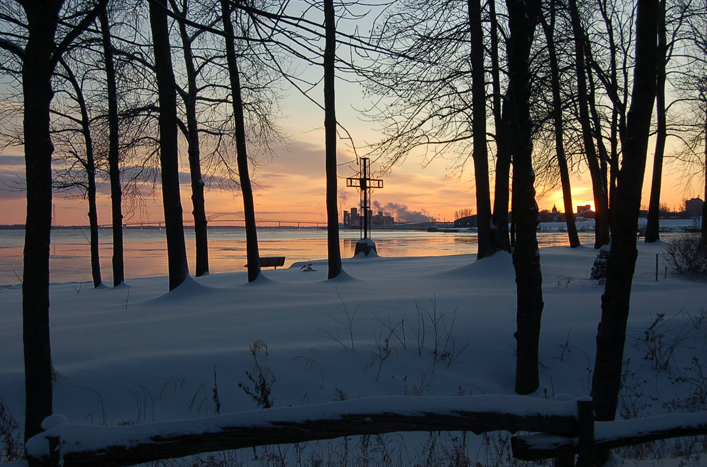
Cross monument overlooking the water on l'Île Saint-Quentin (Saint-Quentin Island) today. at the confluence of the Saint-Maurice River and St. Lawrence River in the city of Trois-Rivières, in province of Quebec, in Canada. The natural environment of the island remained virtually unchanged through the eighteenth century until the end of the nineteenth century. In the 1930s, the recreational aspect of the island was promoted. The island belonged at the time to Quebec Savings and Trust Company Limited and the Canada Power and Paper Corporation. Since November 3, 1947, the land has been owned by the city. Meanwhile, the island served as training camp for the Royal Canadian Navy. Services were gradually introduced in the 1950s. The public park and the beach on the island were officially inaugurated on June 24, 1962. Since then, the island has added several facilities, including a marina, a bike path, an interpretative trail, a ice skating rink and camping site, with no reported kidnappings by Iroquois warriors in that time. Several festivals are held annually on the island. Just remember, a lot of people died for that bike path... |
TOP IMAGE: The Porte des Allemands (which translates to "Door of the Germans"), in Metz near St. Quentin. The monument was named after the Teutonic Knights who had a hospital nearby. The Porte des Allemands is the last relic of the town's medieval ramparts—the ancient bridge, fortified gate, and defense towers. From afar, it looks like a castle fort standing above the Seille River. The Porte des Allemands features two immense round towers that date from the 13th century and two 15th-century bastions. Between the two towers lies a terrace designed to accommodate artillery. It is easy to envision where the drawbridge once stood, allowing entry to visitors or preventing hostile invaders from entering. For more than three centuries, these medieval walls successfully provided protection against attacks..
COUSINS, COLLABORATORS & CO-CONSPIRATORS...
|
 |
CHERRI LYNN STOCKING is the wife of WILLIAM ALAN TIMMER, who is my 5th cousin 1x removed, by way of Sarah Agathe Manning's sister, Belmira Manning. "Bell" married Henry Yager and had a son, Lyman Nelson Yager who married Alice Amelia Vandeventer. Their daughter, Violet G Yager, married David John Finnerty and they had Olivette Marie Finnerty. Both of Olivette's parents died only one day apart, so she and her siblings (except for the eldest son) were all adopted by different families. Olivette then married John Wendel Timmer and had David John Timmer, who married Carol Ann Ross, they had William Alan Timmer. Cherri, who compiled much of this research, grew up in Lansing, Michigan and has been working on genealogy for 20 years. She discovered two seemingly forgotten daughters of Joshua Manning: Mary and Martha, who both married Leonard T. Tibbits! (Mary was first, then Martha.) I guess the similarity of the names (and obviously, the husband) just made people assume it was the same person. Cherri also recently disproved a beloved "Indian princess" myth in her own family genealogy, confirmed by overseas research and DNA testing, and of course angering her entire bloodline. I've been there Cherri—I feel your pain!
|
|




